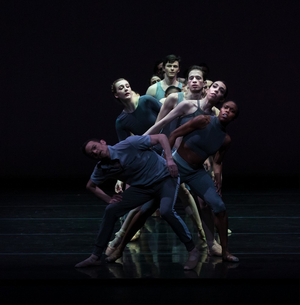Review: Nashville Ballet's ATTITUDE/OTHER VOICES at Tennessee Performing Arts Center
 Nashville Ballet's Artistic Director, Paul Vasterling, approached the company's annual Attitude series - Other Voices - with questions on gender: what does it mean to be a man, what does it mean to be a woman, what does it mean to be both, and what does it mean to be neither? Vasterling commissioned Jennifer Archibald, Erin Kouwe, Matthew Neenan, and Carlos Pons Guerra, in collaboration with Nashville-based musicians, Christina Spinei and Louis York, to create works from those prompts. Company artists appeared energized with work made on them; however, the four-piece program seemed grueling for dancers in terms of movement and content at the 7:30pm performance on Saturday, February 15 at Tennessee Performing Arts Center's Polk Theater.
Nashville Ballet's Artistic Director, Paul Vasterling, approached the company's annual Attitude series - Other Voices - with questions on gender: what does it mean to be a man, what does it mean to be a woman, what does it mean to be both, and what does it mean to be neither? Vasterling commissioned Jennifer Archibald, Erin Kouwe, Matthew Neenan, and Carlos Pons Guerra, in collaboration with Nashville-based musicians, Christina Spinei and Louis York, to create works from those prompts. Company artists appeared energized with work made on them; however, the four-piece program seemed grueling for dancers in terms of movement and content at the 7:30pm performance on Saturday, February 15 at Tennessee Performing Arts Center's Polk Theater.
Pons Guerra's Private Balls featured an all-male cast, costumed in varying levels of dress suggesting the at-home, dance-in-your-underwear kind of intimacy. A range of makeup, jewelry, and garments from boxers to brassieres, all in shades of white and tan suggested a spectrum of identities. In promoting the work, Pons Guerra gave homage to gay men lost to the AIDS crisis and men unable to dance with whomever they loved for various reasons - politics, culture, acceptance, etc. Set to various romantic and post-romantic works accompanied by pianist Alessandra Volpi, ten dancers moved in loosely defined social dance formations, often coupled together, swaying gently in full embrace. Pons Guerra referenced Fokine's Dying Swan, as dancers lunged forward with arms overhead; wrists crossed and included a nod to the Little Swan pas de quatre, though the dancers linked elbows rather holding hands. Pons Guerra explored expressions of masculinity - can men be soft and strong simultaneously without their identity being marginalized?
Tennessee-based choreographer Kouwe, used an all-female cast dressed in white sporty shorts and tanks in Auto Poet, accompanied by Louis York. In program notes, Kouwe described working with the dancers to respond "toward their own method of physical thinking." Kouwe's movement had a fluid rise and fall, dancers' heads initiating direction and action. Movement progressed in speed and complexity, with qualities of tai chi. Patterns repeated, with variation, at multiple levels, often with one dancer above or below another. Dancers moved with lightness and precision, darting towards and away from each other, pausing in tableau. Kouwe flocked dancers in and out of clusters with kaleidoscopic effect; using duos and trios among the entire cast. Whereas, Pons Guerra's piece derived from personal and communal emotions, Kouwe approached from an intellectual, individual basis. Perhaps, the challenge, here, for dancers historically used to molding or performing themselves into another's perspective, was to step out in their own unique identity.
Neenan created There I Was based on his personal journey into self-acceptance featuring Brett Sjoblom and over twenty company dancers moving to Christina Spinei's score, accompanied by Kaitlyn Raitz on cello and Colleen Phelps on percussion. Neenan's composition structure echoed his extensive ballet training; moving dancers in rippling canons frequently, female dancers en pointe, and clearly defined sections. Works of art hung above the stage, with focus shifting throughout the piece. While Pons Guerra used personal experience as a unifying or collective exposition, Neenan's inward focus shifted perspective entirely on Sjoblom's narrative in a Graham-like lens. Sjoblom's draped grey top transformed into a skirt, which he later tore away as he moved through traditional male-female partnering to a tender duet with Michael Burfield. They moved tentatively and cautiously, Burfield appearing to desert Sjoblom when the corps filled the stage. They watched each other from across the stage while other dancers moved between them. Both Neenan and Pons Guerra looked to the past for inspiration; Neenan presented a retrospective while Pons Guerra linked the past to the future. Kouwe dwelt in an academic, intellectual process void of emotional detours.
Archibald's response with Posters played with illusions of sensuality and brutality. Female dancers wore short black unitards, while male dancers were shirtless, with tight black pants. As female dancers moved in formation, perhaps in protective solidarity, male dancers slithered around them, hands hovering over chests, sliding down torsos, or craning neck around neck. If these interactions were consensual, then they were beautifully sensual. If not, they were tormenting threats. Archibald looked to broad experiences; people in attendance could recognize themselves in her work, and depending on perspective might not see the grotesque within the grace.
Spoken word artist Caroline Randall Williams opened and closed Posters; speaking primarily from a feminine perspective and relating behaviors of passion to elements of nature. Joined by the Shindellas, Louis York accompanied dancers. Archibald's work had several beginnings; clarity was needed structurally. The latter part of Archibald's piece was jazzy, without the trauma of sexual threat between male and female dancers. Perhaps, the final section was simply a celebration of gender-positive relations, which felt needed after the heaviness of earlier works. The distinction between artistic medium showed; perhaps, composers and writers are more used to speaking their truth from their own identities, while dancers more frequently portray someone else's narrative, or voices other than their own?
Photo by Heather Thorne.
Videos

